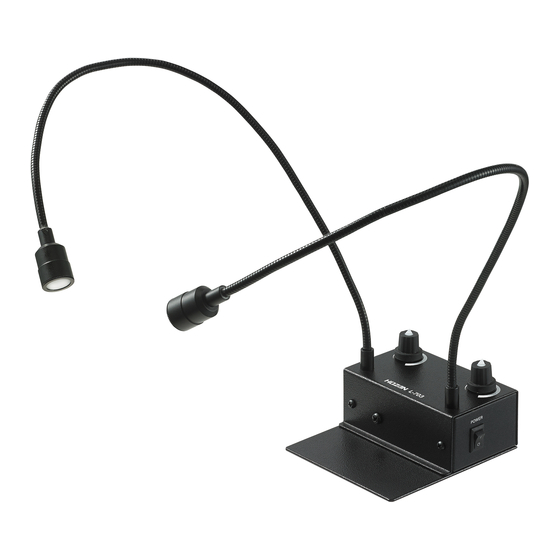
Advertisement
Quick Links
L-703
Thank you for purchasing the HOZAN L-703 LED Flex Neck Light. With proper care and
handling, this instrument will provide years of trouble-free operation. Please read this
entire instruction manual carefully before attempting to place this instrument in service.
Please keep this instruction manual avaliable for reference.
Identification of parts and contents
LED lamps
Diffusion filters
Specifications
LED
LED Life
Color temp.
Rated voltage
Power consumption
Main unit
Dimensions
Arm length 400mm
Weight
LED Flex Neck Light
Base plate
White power LED × 2
Approx. 10000 hrs.
* Varies according to the environment.
6500 K
12 VDC (with AC adapter)
5.1 W
90(W)×37(H)×100(D)mm
(With base plate)
90(W)×35(H)×58(D)mm
(Without base plate)
425g
INSTRUCTION MANUAL
Flexible arms
Light brightness (at full power)
Distance from
light source
(mm)
1 light
2 lights
*Calculated value
1
Accessory
AC adapter
Brightness adjust knobs
Power switch
Without filter
(lx)
50
100
249000*
81000
337000*
126800
With filter
(lx)
50
100
35400
11500
38300
14400
Advertisement

Summary of Contents for HOZAN L-703
- Page 1 L-703 LED Flex Neck Light Thank you for purchasing the HOZAN L-703 LED Flex Neck Light. With proper care and handling, this instrument will provide years of trouble-free operation. Please read this entire instruction manual carefully before attempting to place this instrument in service.
- Page 2 Warning and caution symbols These symbols are used throughout the instruction manual to alert the user to potential safety hazards as follows: … Notice when incorrect handling could cause the user's death or serious Warning injury. Caution … Notice when incorrect handling could cause injury to the user or material damage.
- Page 3 Operation Caution ・ The Flexible arms are wound springs. If a large force is applied in the twisting direction (in the direction in which the winding spring tightens or loosens), it may cause damage. When changing the pull-out angle, be sure to stretch it straight once, completely remove distortion in the twist direction, and pull it out in the desired direction again.
Need help?
Do you have a question about the L-703 and is the answer not in the manual?
Questions and answers